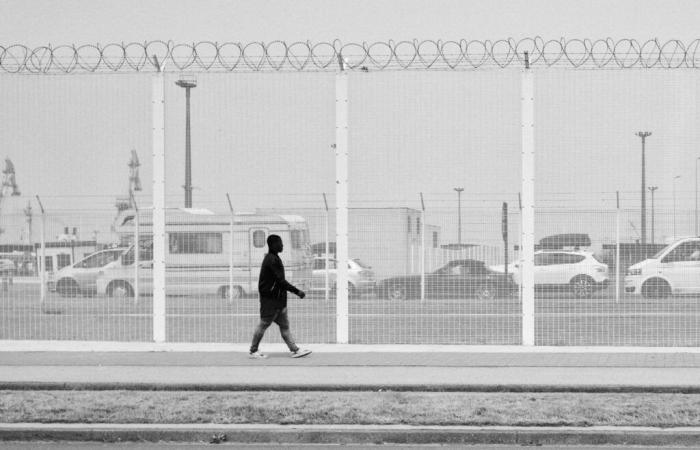British author and photographer Johny Pitts publishes Afropean: A Journal chez Morel Booksa new chapter in his long-term work on the question of black identity in Europe.
Who hasn't dreamed of an Interrail trip? Since 1972, this rail pass has erased borders and constitutes the gateway to any student keen to discover European territory at a lower cost. But what is Europe? What is European identity? In 2010, when he set off on his own tour of the continent with an Interrail pass, these are the questions that Johny Pitts tried to answer.
Originally from Sheffield in the United Kingdom, born to an English mother of Irish origin and an African-American father, he grew up in a neighborhood that he describes as multicultural. As a child, his group of friends was a mix of “working class whites, Jamaicans, Somalis, Yemenis…” In the era of New Labor and Tony Blair, everyone feels “very European”. In a photograph in the book, at perhaps eight or ten years old, we see him proudly wearing his “Europe” t-shirt.
After the attacks of September 11, 2001, he nevertheless noticed a crack. This became a real break seven years later at the time of the subprime crisis: “I couldn't really put it into words at the time, but I started to notice a lot of divides, across the political spectrum, but also within my own group of friends. »In the young man, this triggers a desire to meet Europe: “I wanted to reevaluate what it meant to bebeing a black European and living in a multicultural Europe. »
Paris, Brussels, Amsterdam, Berlin, Stockholm, Moscow, Marseille, Lisbon… Johnny Pitts sets out to meet those he calls Afropeansborrowing a musical term whose authorship goes to the singer David Byrne and the group Zap Mama. He finds them on the outskirts, in Clichy-sous-Bois near Paris or Rinkeby in Stockholm. In the heart of the cities, it is the national clichés that he seeks, to divert them through a person who we rarely see associated with this type of symbols. In London, for example, he is a guard at Buckingham Palace. In Rome, it is an ancient statue. In Moscow, he watched Pushkin, whose African origins many forget.
Because it is not “the experience of immigration in Europe” that Johny Pitts seeks to transcribe but rather to highlight the multicultural reality of European roots: “I’m not trying to exoticize. What I'm trying to observe is a natural black identity, which has been part of Europe for a long time. And that's where the concept of Afropean comes in. It's not saying, “Oh, they're black people in Europe.” »No, they are black people from Europe. »
From these meetings, he draws the first essay ever published on Afro-European identity in which he mixes the words of the writers who influenced his thinking with the testimonies of those he met to show how these individuals reinvent their identity, countering the clichés which obscure Europe's relationship to its origins.
The work he publishes today with Morel Books is a visual chronicle of his journey. Combining 300 pages of photographs, texts, note-taking and memories, the work, inspired by the form of the scrapbook, constitutes an immersive experience, which takes us with him through the different cities of his railway roadtrip. Johny Pits and his editor Aron Morel thought of the object as a “haptic book”playing in particular with different types of paper, a desire which for the author dates back to a memory of adolescence, when he had in hand a series of albums produced by the musical collective Soulquarians which used a special paper allowing one to feel at touch the music on the CD. There is also something very musical in the sometimes jerky rhythm of the book.
The photographs which appear full page after full page immerse us in a similar rhythm, between the spontaneity of the snapshot and the aesthetics of error. Inspired by Stanley Greene — himself inspired by Roy Decarava — Johnny Pitts talks about “photography on the verge of failure” [« photography at the edge of failure »]. The motion blurs, the play of reflections or light create an ambient poetry which responds to more direct images, and in particular the numerous portraits which populate this odyssey, the faces of Afropeanity.
Afropean: A Journal is a hybrid object, halfway between anthropological study, personal notebook and visual experimentation. It immerses us in the world of this author who devoted his life to redefining the contours of Europe, to showing the richness of its heritage and the multiculturalism which is its strength. For Johnny Pitts, “Black Europe is ancient. Black Europe also belongs to the future!!! »
Zoe Isle de Beauchaine
Johny Pitts – Afropean: A Journal
Published by Morel Books
Edition: 1500
294 pages
241 x 184 mm, portrait
Available online and in all good bookstores.
www.afropean.com
www.johnypitts.com
www.morelbooks.com






